One of the most enigmatic and discussed paintings in theentire history of art shows itself in all its fascination to the visitor who arrives in the last room of the Borghese Gallery: it is the work by Tiziano Vecellio (Pieve di Cadore, 1488/1490 Venice, 1576) known as Amor sacro e Amor profano. A large canvas, nearly three meters wide and a little over one meter high, whose protagonists are two florid young women who stand at the sides of a white marble basin, adorned with a classical frieze and located at the exact center of the scene. Water gushes from a reed placed above the central slab, while two vessels rest on the rim: a silver basin, and a vase that the woman on the left touches with her hand. The young woman is richly attired in a marvelous white, satin tunic, which covers a red robe (one sleeve of it sticks out) and is stopped at breast height by a belt with a gold buckle. She looks toward us, but without directly meeting our gaze: she seems almost more intent on holding to herself the vase and the small bouquet of roses which, with her right hand, covered with a glove exactly like her left, she holds resting on her knee. She is combed like her counterpart: a completely nude young woman with identical somatic features, so much so that we are led to believe that the two women are actually the same person. Generous but at the same time delicate forms, her legs crossing each other, a red cloak running from her shoulder down to her feet, a white loincloth that enhances the vivid color of the skin blushing on her cheeks, her right arm resting on the basin and her left arm raised, her hand holding a brazier from which black smoke is coming out. Between them, a putto stirs the waters of the tub.
Behind it is a typically Venetian landscape of rolling hills that hint at more rugged reliefs in the distance. It almost seems as if Titian wanted to divide the landscape into two sections, equally divided by a leafy tree that stands in the center of the scene, exactly behind the putto, so that each of the two portions accompanies one of the two women. To the left, behind the clothed woman, is a mountain landscape, with a village built on top of the mountain, over which towers the circular tower of a castle. On the right, a gentler lake landscape, with another village, its outline marked by a bell tower, lying on the shores of the lake, and with a forest at the edge of the body of water. It is a living landscape: there are animals (two bunnies), and mostly human presences. In the mountain village, some characters bustle in front of the gateway as a horseman arrives. Near the woods on the lakeshore we see hunters on horseback with their retinue of dogs, and a shepherd leading a flock of sheep.
The coloring is typical of Titian shortly after his beginnings. Full and warm, luminous, filled with iridescence and strong with a wide range, which is enriched with even sharp contrasts: The drape of the nude young woman stands out, which with its bright red abruptly interrupts the sloping towards the shadows from the landscape and highlights the delicate complexions of the girl, but among the coloristic peaks of the work it is also necessary to emphasize the shadows of the draperies of the clothed woman, which change the white of her dress into a riot of pearly and silver accents, as well as the luminous glimpses of the sky at sunset that enhance the blue outline of the mountains in the background and evoke Venetian atmospheres.
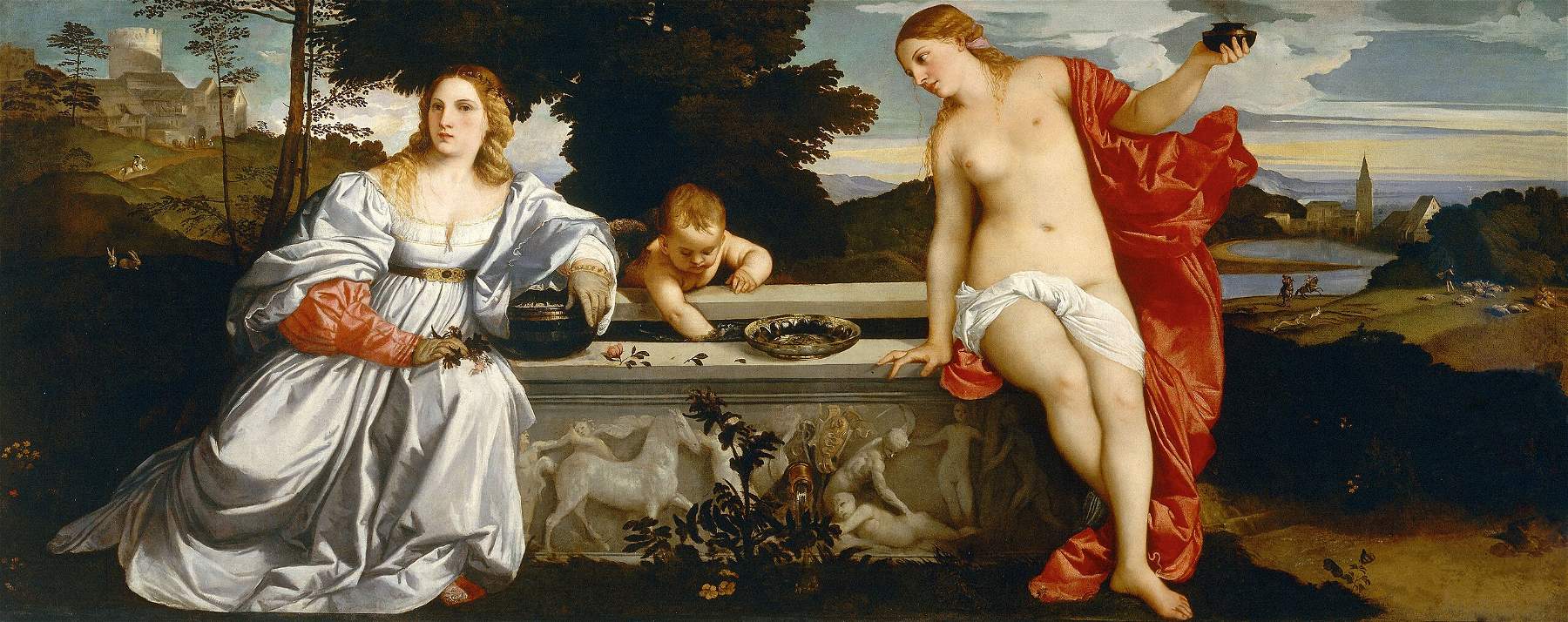 |
| Titian, Amor sacro e Amor profano (1515; oil on canvas, 118 x 278 cm; Rome, Galleria Borghese) |
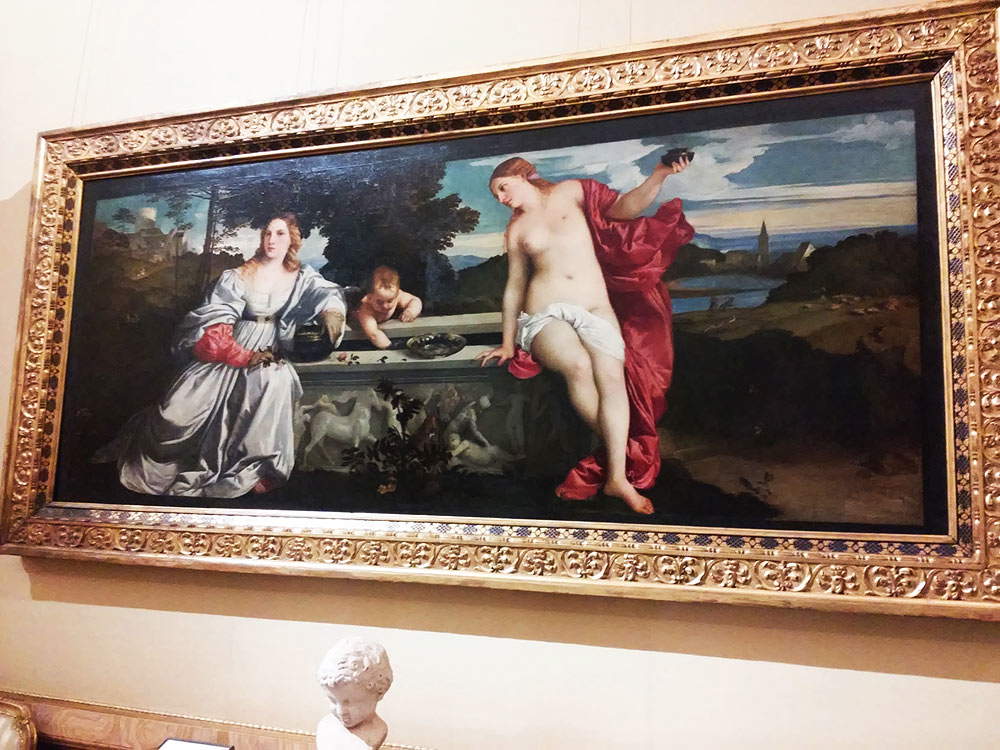 |
| Titian’s painting at the Galleria Borghese |
The title by which the work is universally known, Amor sacro e amor profano, is actually later than the painting was made: it is borrowed from an inventory of the Galleria Borghese dating from 1693 (even today the painting is kept at the Gallery: in all likelihood it arrived there in 1608, when Scipione Borghese bought it along with other paintings from Cardinal Paolo Emilio Sfondrati, but we do not know for sure where it was before that) and which indicated the painting as “L’Amore divino et Amore profano con un amorino che pesca dentro una vasca al no. 462 by Titian with a gilded frame,” later definitively becoming “Amor sacro et Amor profano” in 1792 with the guide to Rome compiled by Giuseppe Vasi, the first to use the expression that knew the widest fortune. However, that of 1693 is not the first attestation of the Titian painting, nor was it the first time the work was given a title that sought to make its content explicit. Prior to the 1693 inventory, the references are purely descriptive: a manuscript on the Gallery compiled in 1613 by Scipione Francucci indicates the work simply as “Beltà disornata e Beltà ornata,” while in 1648 Carlo Ridolfi, in his treatise Le maraviglie dell’arte, wrote that in the home of Prince Borghese there was a painting depicting “two women near a fountain, within which is mirrored a child.” In 1650 the first title in which there is an attempt to identify the subject of the painting is recorded: Giacomo Manilli, in a description of Villa Borghese outside Porta Pinciana, in fact reported the existence of the painting “grande de’ tre Amori” by Titian. So it was probably through Manilli’s cue that the 1693 inventory attempted to identifysacred Love andprofane Love in the two women, and this reading was destined to orient the positions of critics for a very long time. Moreover, there was never agreement on which of the two was Sacred Love and which was Profane Love, since each of the two women could be assigned attributes valid for either thesis (the chastely clothed woman symbolizing Sacred Love and the sensual nude symbolizing Profane Love, but also the rich clothing symbolizing worldliness and therefore Profane Love, and the nudity allegory of purity, symbolizing Sacred Love).
Nineteenth-century art historians settled on allegorical and moral interpretations: Wilhelm Lübke, in 1878, interpreted the subject as “love and chastity,” Moritz Thausing (1884) spoke of “desire for love and fulfilled desire,” while already in Italy Giovanni Battista Cavalcaselle and Joseph Archer Crowe (1877) had proposed to see in the clothed woman the “satiated love” and in the nude woman the “naive love” (this was, moreover, the first time since 1792 that the title of the work was proposed to be changed). Deviating from this type of reading was Franz Wickhoff, in 1895, who proposed a literary interpretation: for the Austrian scholar, Titian had taken the subject from the seventh book of Valerius Flaccus’ Argonautics, and the scene would depict Medea (the clothed woman) being addressed by Venus to persuade her to go to the woods behind them in order to meet Jason. Wickhoff’s interpretation, which, although weak in terms of identifying the characters (in fact, decisive elements were lacking to affirm their identities with certainty: the clinging to the vase as the one that would contain the sorceries with which Medea would help Jason in his exploits was too labile), had the merit of reading the work as an allegory of theinvitation to love, secured a wide resonance and was much discussed: among the first to reject Wickhoff’s theory was Italo Mario Palmarini (1902), who also attempted (with very suggestive hypotheses, but based on very vague foundations) to reconstruct the history of the work. For Palmarini, the two young women painted by Titian showed similarities to the very famous painting known today as the Woman in the Mirror, which for the scholar represented Laura Dianti, mistress of Alfonso I d’Este. According to the author, the work had been executed during the period when Titian worked for the Este family, and the theme would have been suggested to him precisely by the duke, who allegedly asked the artist to refer to Matteo Boiardo ’sOrlando innamorato and to depict his own favorite, clothed and naked, above the fonte d’Ardenna, the fountain of love sung by the poet in his work. Palmarini’s hypothesis was dryly rejected, again in 1902, by Umberto Gnoli, who, making a mockery of his colleague’s historical reconstruction (“Away, this is how novels are made, not the history of Art!”), took Wickhoff’s hypothesis at face value instead, proposing to confirm it. Still, in 1906 Leandro Ozzola speculated that the subject of the painting was taken from Book III of the Aeneid and depicted Venus urging Helen to abandon Menelaus.
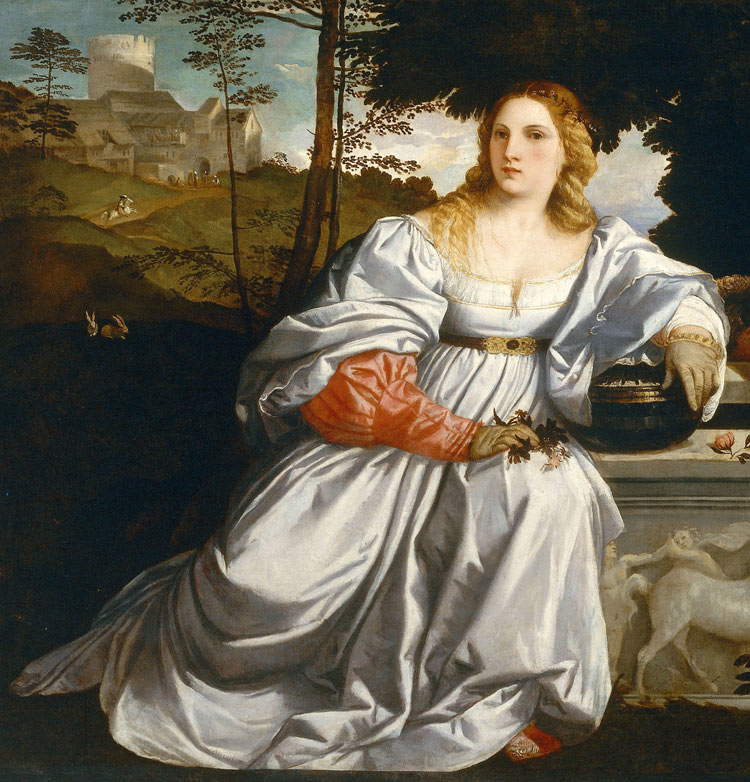 |
| The clothed woman |
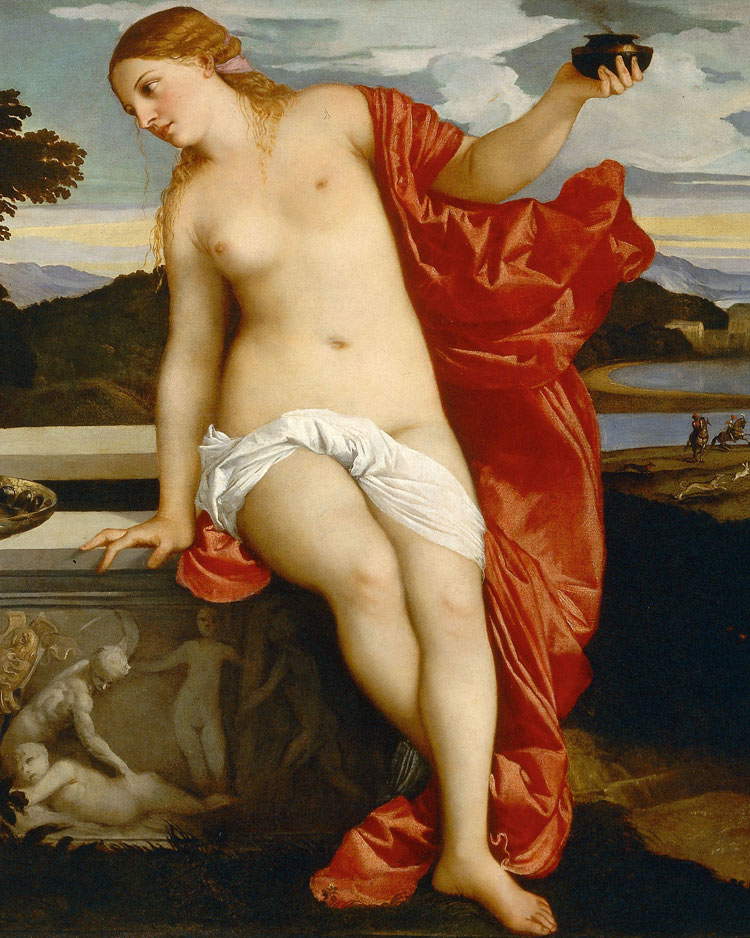 |
| The nude woman |
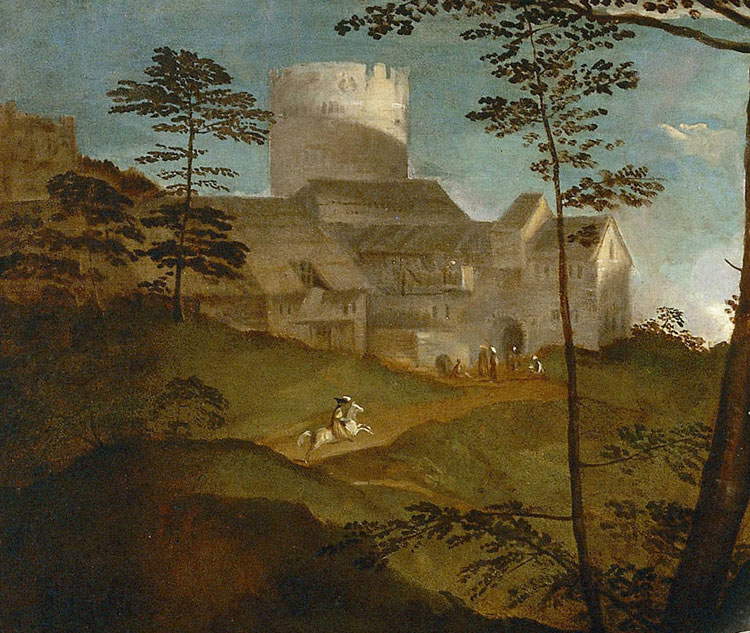 |
| The landscape behind the clothed woman |
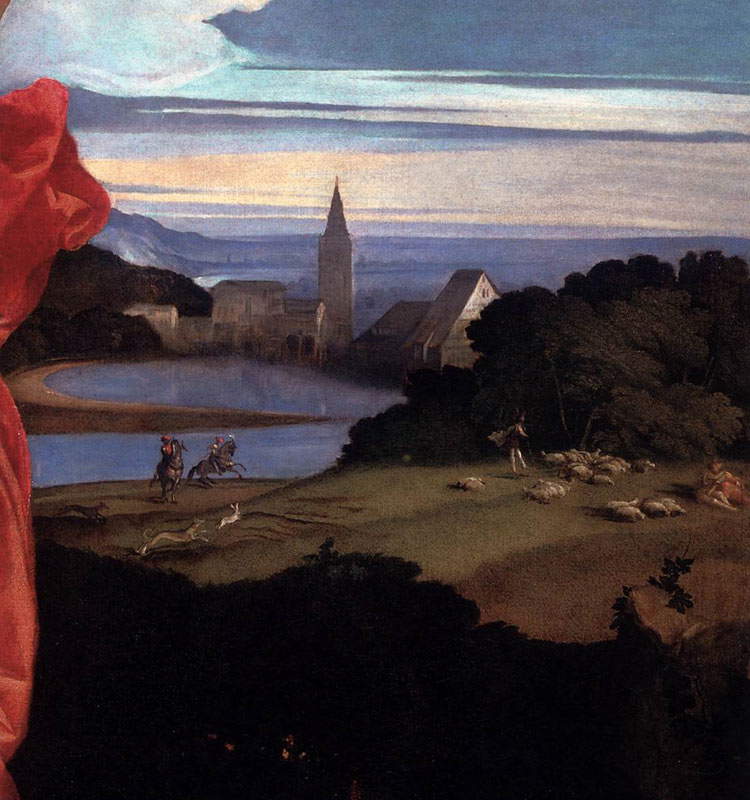 |
| The landscape behind the naked woman |
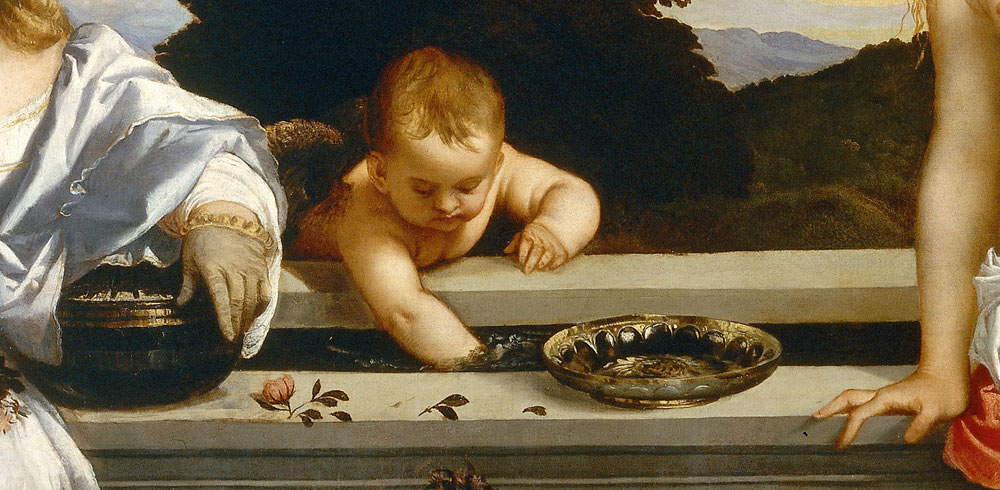 |
| Cupid stirs the waters of the pool |
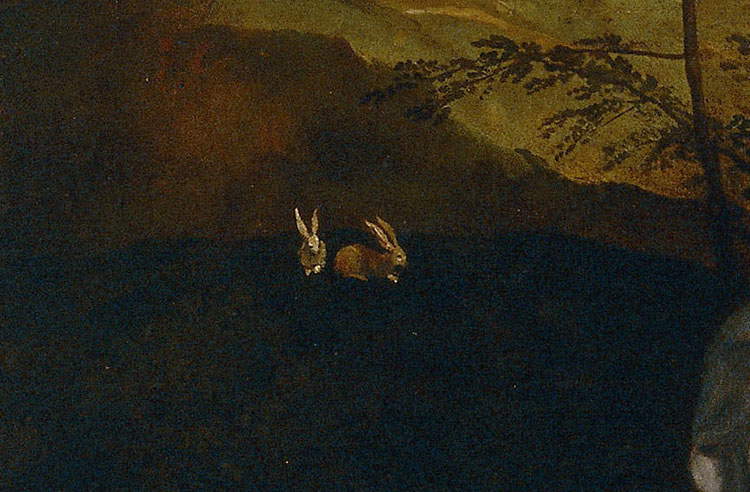 |
| The two rabbits |
In 1910, Olga von Gerstfeld opened a new thread: the scholar thought that the two women painted by Titian were the goddess Venus and the young Violante, Palma the Elder’s daughter, toward whom Titian is said to have harbored amorous feelings. Accepting the hypothesis of the invitation to love, that of the narration of a personal affair, and that of the literary subject, in 1917 Louis Hourticq, in a contribution entitled La fontaine d’amour de Titien (an important essay in that he was the first to try to link the painting closely to the Venetian cultural milieu of the time) thought that the Venetian painter had drawn inspiration from a novel attributed to Francesco Colonna, theHypnerotomachia Poliphili, which was published in Venice in 1499 and enjoyed great success (as early as 1913 Josef Poppelreuter had pointed to it as a possible source forAmor sacro and Amor profano, but he later came to different conclusions). In particular, Hourticq suggested that the basin in the center of the scene was the sarcophagus of Adonis, with Cupid collecting his blood and then offering it to Venus, to which the two protagonists of the novel, Polia and Poliphilus, arrive, and equally to them, according to Hourticq, Titian would have led his beloved Violante to the same place, in the presence of the goddess Venus. Hourticq’s hypothesis was widely echoed and was favorably received, albeit often with variations, by several scholars (Graziano Paolo Clerici, Max Friedländer, August Mayer, and many others), many of whom tried to identify in the clothed young woman the Polia protagonist of theHypnerotomachia Poliphili.
Another particularly successful strand was the one that attempted to unravel the knots on a philosophical basis. According to such readings, Amorsacro e Amor profano would be influenced by the humanistic culture of the time and would be nourished by the neo-Platonic philosophy that was widespread in the cultural circles of early sixteenth-century Venice: Titian, moreover, was a friend of Pietro Bembo, a writer and poet whose work is steeped in neo-Platonic philosophy, and Titian’s masterpiece would be influenced by that climate (according to some, the subject was suggested by Bembo himself). In this sense, probably the most famous reading is that of Erwin Panofsky, who proposed identifying the two women as the two Venuses, the celestial (nude) and the earthly (clothed), with Cupid stirring the waters in the fountain as a symbol of the link between heaven and earth. However, in 1948 Edgar Wind, in his important essay Pagan Mysteries of the Renaissance, criticized Panofsky’s theory, arguing that Titian actually wanted to deal with aninitiation into love in an allegorical key (and yet still in accordance with Neoplatonic philosophy), with the Pulchritudo, Beauty (represented by the clothed young woman) being led to Voluptas, or Pleasure, through Love.
It is plausible, however, that the most correct interpretations are those that began to circulate from the 1980s onward and that link the painting to a marriage, and this also in light of the most recent discoveries that would have made it possible to overcome many of the hypotheses formulated previously. In the center of the fountain, in particular, is a coat of arms: it is that of a Venetian patrician, Niccolò Aurelio, and had been well identified in the past, so much so that already the aforementioned August Mayer had speculated that the commissioner of the work was indeed Niccolò Aurelio. The story of these would constitute the tragic prologue that would lead to the creation of Amorsacro e Amor profano. In 1509, Aurelio was the secretary of the Council of Ten, an important institution whose purpose was to ensure the security of the Republic of Venice. In 1509, the Council had condemned to death a jurist and law professor, Bertuccio Bagarotto, from Padua, who had been accused of high treason.We are in the period of the Italian wars, and in particular in the context of the conflict between the Republic of Venice and the League of Cambrai, which brought together several European powers (Holy Roman Empire, France, Spain, Papal State, Kingdom of Hungary, Kingdom of Naples, Duchy of Ferrara, Duchy of Savoy, Marquisate of Mantua). After the bitter defeat Venice suffered at Agnadello on May 14, several cities of the Republic attempted to break away from Venice and place themselves under the imperial aegis: the same happened in Padua, which was abandoned by the Serenissima authorities and was occupied by the imperials. Bagarotto remained in Padua and attempted to mediate between Venice and the Empire, continuing to be formally part of the city government but without actively participating in it. When the Venetians recaptured the city, Bagarotto and others were considered traitors, convicted and then hanged in Venice on December 1. The Republic rehabilitated the memory of Bagarotto, executed though innocent, a few years later, and to “repair” the damage done to the family, Niccolò Aurelio, in 1514, married Bertuccio Bagarotto’s daughter Laura, whose first husband, Francesco Borromeo, probably met the same fate as her father.
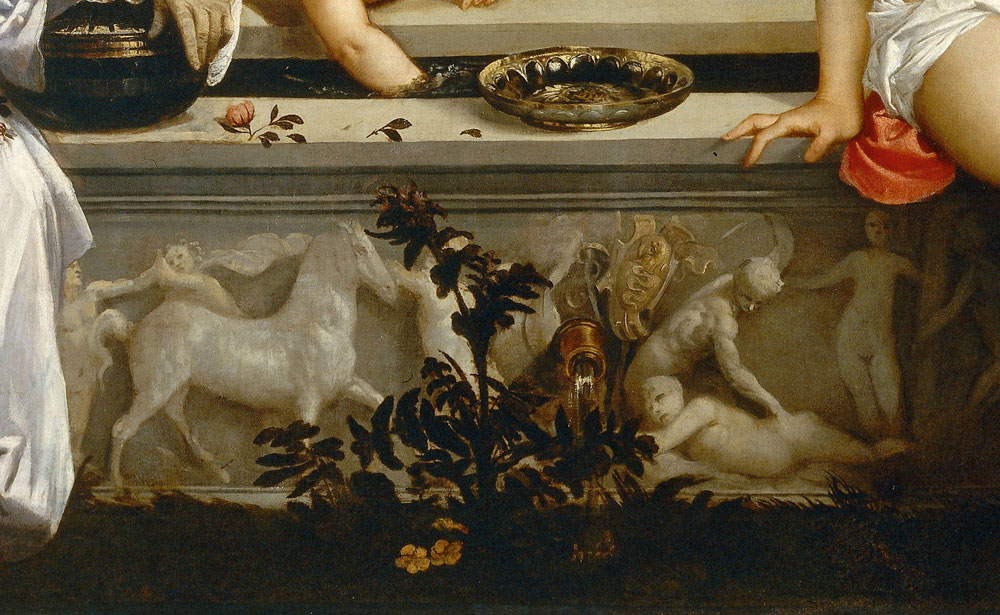 |
| The pool |
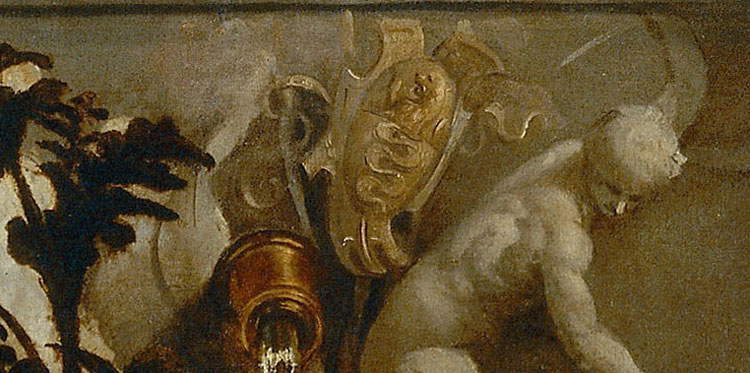 |
| Niccolò Aurelio’s coat of arms in the center of the tub. |
It is likely that the painting originated on the occasion of this wedding, not least because the clothed woman presents all the typical attributes of the bride (the white dress, the gloves, the closed belt, the bouquet of roses, the myrtle wreath) and because other allusions to marriage would appear (the pair of rabbits symbolizing fecundity, the basin interpretable as a birthing table): as Augusto Gentili suggested, the painting could constitute the transformation of the memory of a tragic event into an allegory celebrating life. In addition, a document found in 1993 by Rona Goffen in the State Archives of Venice speaks of a white silk robe owned by Laura Bagarotto: it was immediately related to the one that the young woman inAmor sacro e Amor profano sports in the painting. Others, on the other hand, wanted to identify in the basin the coat of arms of the Bagarotto family (a hypothesis, however, not confirmed, given the difficulty of reading the detail). Having thus clarified the occasion on which the painting was made, the circle of hypotheses has narrowed to nuptial interpretations. For Maria Luisa Ricciardi, the clothed woman is Laura Bagarotto, while the naked young woman is the goddess Venus who invites her to go to Venice (according to these hypotheses, the two cities behind the two women would be Padua and Venice, respectively). Giles Robertson followed this reading, modifying it: the clothed girl is still Laura Bagarotto (clutching the urn with her father’s ashes), while the nude woman is the personification of Truth who informs the observer of her father’s unjust death (it should be noted that, according to such readings, the bas-relief of the basin, which contains a scene of punishment, could be read as a reference to Bertuccio Bagarotto’s story). For the aforementioned Rona Goffen, the clothed woman is an allegory of the bride promising love to her husband, while the naked woman is the wife exhorting the bride to love. More recent hypotheses include that of Heiner Borggrefe, according to whom the painting represents Venus instructing Laura Bagarotto in the context of her marriage to Niccolo Aurelio. In recent years, on the other hand, a hypothesis has gained credence that takes its cue from an intuition that Charles de Tolnay launched in the 1970s, indicating in the clothed young woman the figure of chastity and in that of the nude, again, the goddess Venus: the theory has thus gained ground that the two women represent the two virtues of the bride, chastity and sensuality, with Cupid stirring the waters to find the right balance between the two opposites. A hypothesis that, moreover, is fully situated within the Venetian culture of the time, since the problem of reconciling passion and spirituality emerges in the works of the literati of the time, Bembo above all.
As much as the latest discoveries have helped to bring some clarity, to remove some certainly inconsistent hypotheses (a broad, but necessarily incomplete, reconnaissance has been provided in this article) and to take stock of what has historically emerged around the painting (in this sense, the 1995 exhibition on the work, curated by Maria Grazia Bernardini, was of great use), several unanswered questions still remain. The iconographic theme is unprecedented, and it is still not possible to establish with certainty what its meaning is. We do not know which cities are represented in the background, we do not know if there are really links to literature, we do not even know if the two figures are to be read as complementary or contrasting. Perhaps the doubts about Titian’s Amorsacro e Amor profano, one of the most enigmatic and mysterious paintings of all time, will never be definitively dissolved. But it is perhaps also in the improbability of this event that much of the fascination of this wonderful work of art lies.
Reference bibliography
Warning: the translation into English of the original Italian article was created using automatic tools. We undertake to review all articles, but we do not guarantee the total absence of inaccuracies in the translation due to the program. You can find the original by clicking on the ITA button. If you find any mistake,please contact us.